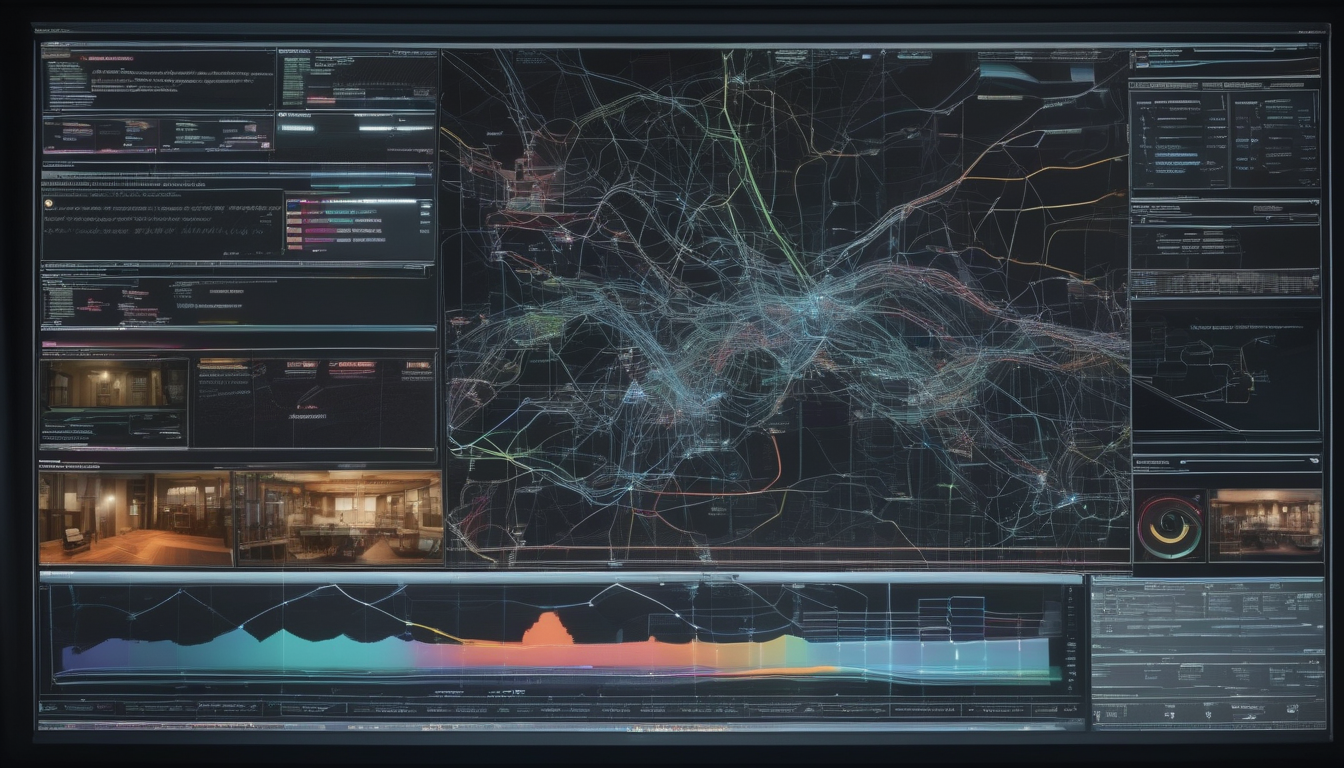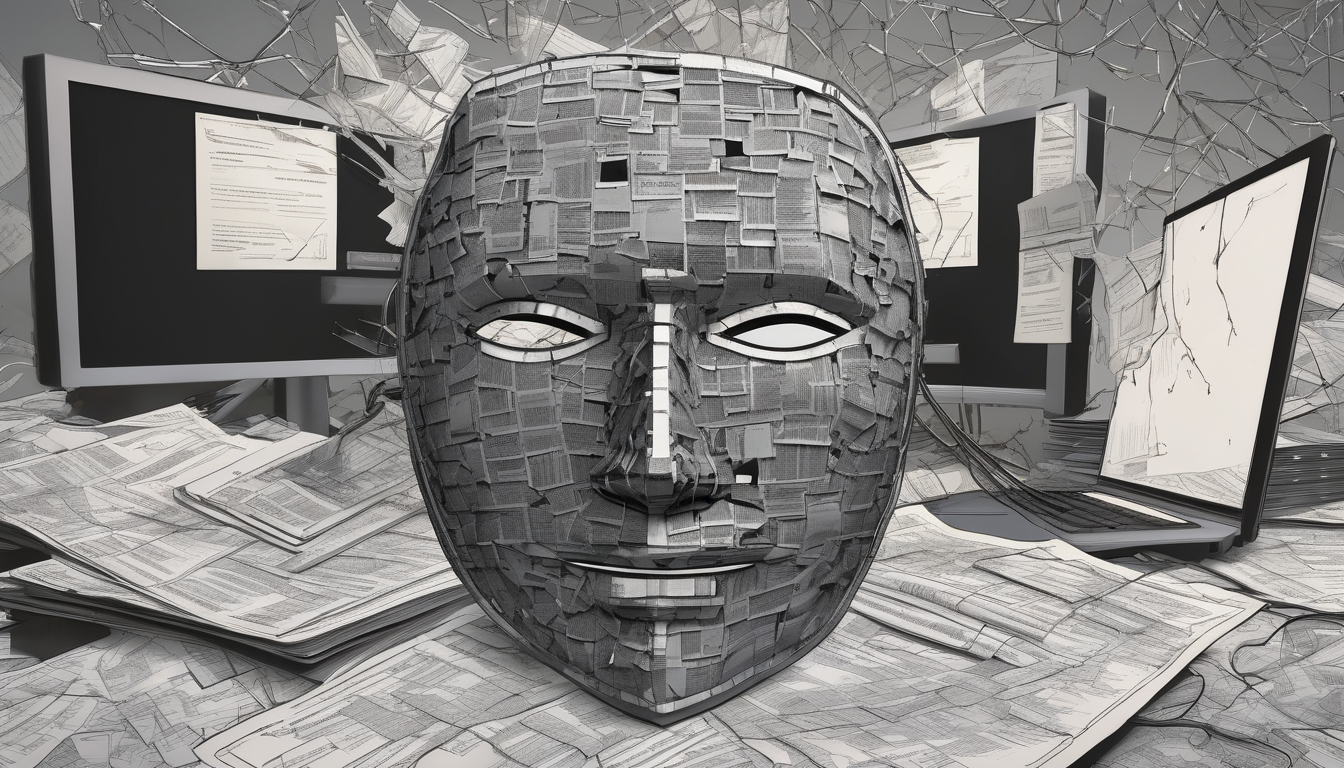The Dangers of Deepfakes: AI’s Dark Side

Deepfake technology has emerged as one of the most alarming advancements in artificial intelligence, raising serious concerns about its impact on our society. Imagine a world where reality can be manipulated with the click of a button, where images and videos can be altered so convincingly that distinguishing truth from fiction becomes nearly impossible. This is the unsettling reality we face with deepfakes, which use sophisticated algorithms to create hyper-realistic media that can deceive even the most discerning viewer.
At its core, deepfakes are a product of machine learning, where AI systems are trained on vast datasets of images and videos to generate new content. The technology has progressed rapidly, making it easier for anyone with basic technical skills to create and distribute deepfake media. As a result, we are witnessing a surge in the use of deepfakes across various domains, from entertainment to misinformation campaigns. The implications of this technology are profound, as it poses a threat not only to individual privacy but also to the very fabric of our democratic institutions.
One of the most pressing issues is the potential for deepfakes to spread misinformation. With the power to fabricate events or statements, deepfakes can easily manipulate public perception and sow discord. For instance, during election cycles, the dissemination of deepfake videos can influence voter opinions and undermine trust in legitimate news sources. As people become increasingly skeptical of the media, the lines between fact and fiction blur, creating a dangerous environment where truth is subjective.
Moreover, the misuse of deepfake technology raises significant privacy concerns. Individuals can become victims of deepfakes, facing harassment or reputational damage due to unauthorized alterations of their likeness. This is particularly alarming in cases where deepfakes are used to create non-consensual explicit content, leading to severe emotional and psychological consequences for the victims.
In light of these challenges, it is crucial to explore preventive measures. Governments and tech companies are beginning to recognize the need for regulations and technological solutions to combat the proliferation of deepfakes. By investing in detection tools and establishing clear legal frameworks, we can work towards a safer digital landscape where the integrity of information is preserved.

Understanding Deepfakes
Deepfakes are a fascinating yet alarming manifestation of artificial intelligence (AI) technology. Essentially, they are AI-generated media that convincingly alter reality, making it difficult for the average person to discern what’s real and what’s fabricated. But how do these digital chameleons come to life? At their core, deepfakes rely on advanced machine learning techniques, particularly a subset known as generative adversarial networks (GANs). This technology involves two neural networks—a generator and a discriminator—working in tandem to produce increasingly realistic images or videos.
Imagine a game of cat and mouse, where one player tries to create something that looks real, while the other tries to catch the fake. Over time, this relentless competition leads to astonishingly lifelike results. The advancements in AI have made it easier than ever to create deepfakes, and this raises a crucial question: What are the implications of such powerful technology?
To understand the full impact of deepfakes, it’s important to recognize their potential uses, both good and bad. While they can be used for harmless entertainment, like creating funny videos or parodies, their darker applications are far more concerning. For instance, deepfakes can be utilized to:
- Spread misinformation
- Manipulate public perception
- Invade personal privacy
As we delve deeper into this topic, it’s evident that the technology behind deepfakes is evolving rapidly. With each passing day, the line between reality and fabrication becomes blurrier, leading us to a critical juncture where we must question our trust in visual media. The implications of this technology extend beyond mere entertainment; they touch on fundamental issues of ethics, privacy, and truth. As consumers of media, we must remain vigilant and informed about the tools that can distort our perceptions of reality.

Impact on Misinformation
Deepfakes are not just a technological curiosity; they represent a serious threat to the integrity of information in our digital age. Imagine waking up one morning to find a video of a public figure saying something utterly outrageous. What if that video was so convincing that it made headlines around the world? This is the reality we face today, where manipulated media can easily go viral, spreading false narratives and creating chaos.
The consequences of deepfake technology extend far beyond mere entertainment. They erode trust in media, making it increasingly difficult for the public to discern truth from deception. In an era where misinformation spreads like wildfire, deepfakes amplify this issue, leading to a society where skepticism becomes the norm. People may begin to question the authenticity of even the most legitimate sources, which can have a ripple effect on public discourse and democracy.
One of the most alarming aspects of deepfakes is their potential for political manipulation. For instance, during election seasons, a deepfake could be used to falsely portray a candidate making inflammatory statements, thereby swaying public opinion. These instances not only undermine individual candidates but also threaten the very fabric of democratic processes. Below is a table illustrating some notable examples of deepfake incidents in politics:
| Incident | Year | Impact |
|---|---|---|
| Deepfake of a CEO | 2020 | Stock market manipulation |
| Political Candidate Video | 2021 | Voter misinformation |
| Fake News Broadcast | 2022 | Public unrest |
As if that weren’t enough, the issue of misinformation is compounded by the speed at which deepfakes can be produced and shared. A well-crafted deepfake can go viral in a matter of hours, leaving little time for fact-checkers to debunk it. This rapid dissemination creates a challenging environment for those striving to maintain the truth. In the end, we must ask ourselves: how do we combat this wave of misinformation? The answer lies in education, awareness, and the development of advanced technologies aimed at detecting deepfakes before they can cause harm.
Political Manipulation
In today’s digital age, the influence of deepfake technology on politics is nothing short of alarming. Imagine a world where a video of a political leader saying something outrageous could be completely fabricated. This isn’t just a thought experiment; it’s a reality that we are increasingly facing. Deepfakes have the potential to manipulate public opinion, sway elections, and even destabilize democracies. The ability to create hyper-realistic videos that can misrepresent the truth raises serious questions about the integrity of our political systems.
Consider the implications: a deepfake video could show a candidate making inflammatory statements, causing public outrage and potentially altering the course of an election. The rapid spread of such content on social media platforms can lead to misinformation becoming the new norm. As these technologies advance, the line between reality and fiction becomes increasingly blurred, making it difficult for voters to discern the truth.
There have been several notable instances where deepfakes have been used in political contexts, leading to widespread concern. For example:
- A deepfake video of a politician making controversial remarks went viral, sparking protests and calls for resignation.
- Another instance involved a fabricated video used in a smear campaign against a candidate, leading to significant damage to their reputation.
These examples illustrate the profound impact that deepfakes can have on political discourse. The ability to manipulate video content not only threatens individual candidates but also undermines the trust in democratic institutions. As misinformation spreads, voters may become disillusioned, questioning the reliability of all media sources.
To combat this growing threat, it is crucial for governments and tech companies to collaborate on developing robust detection methods. Implementing technology that can identify deepfake content is essential in preserving the integrity of information. Additionally, public awareness campaigns can educate citizens about the existence and risks of deepfakes, empowering them to critically evaluate the media they consume.
In conclusion, the potential for deepfakes to manipulate political landscapes is a pressing issue that demands immediate attention. As we navigate this new frontier, it is vital to establish safeguards that protect our democratic processes from the dark side of artificial intelligence.
Case Studies
When we think about the real-world implications of deepfake technology, several alarming case studies come to mind. These instances not only illustrate the potential for misuse but also highlight the urgent need for awareness and action. One of the most infamous examples involved a deepfake video of former President Barack Obama. In this instance, an AI-generated video made it appear as if he was saying things he never actually said. This incident sent shockwaves through media circles and raised questions about the authenticity of video content. It served as a wake-up call, showing just how convincing deepfakes can be and how they can manipulate public perception.
Another notable case is the use of deepfakes in the adult entertainment industry. This troubling trend involves taking the likeness of unsuspecting individuals, often celebrities, and superimposing them onto explicit videos without their consent. Not only does this violate personal privacy, but it also leads to severe reputational damage for the victims. The impact on individuals can be devastating, leading to emotional distress and public humiliation. This phenomenon has sparked debates about consent and the ethical considerations surrounding the use of someone’s likeness.
In the political arena, deepfakes have been used to create false narratives that can sway public opinion. A striking example occurred during a recent election cycle when a deepfake video made it seem like a candidate made inflammatory remarks about a sensitive topic. The video went viral, leading to widespread misinformation and confusion. Although the video was later debunked, the damage was done. This incident highlights how quickly misinformation can spread and the challenges faced in correcting false narratives in the age of digital media.
To better understand the impact of these case studies, consider the following table summarizing key incidents involving deepfakes:
| Incident | Description | Impact |
|---|---|---|
| Obama Deepfake | Video of Obama saying false statements | Raised awareness about video authenticity |
| Celebrity Non-consensual Deepfakes | Use of likeness in adult videos | Severe privacy violations and reputational damage |
| Political Deepfake | Manipulated video of a candidate | Spread of misinformation during elections |
These case studies underscore the need for vigilance and proactive measures to combat the malicious use of deepfake technology. As we navigate this complex landscape, it becomes increasingly crucial to educate ourselves and others about the risks associated with deepfakes, ensuring we can better discern reality from manipulation.
Preventive Measures
As the threat of deepfakes looms larger, it becomes crucial to explore that can help curb their misuse. The first step in this battle is to enhance technological solutions. Companies and researchers are developing sophisticated detection tools that leverage AI to identify deepfake content. These tools analyze videos and images for inconsistencies, such as unnatural facial movements or mismatched audio. However, technology alone cannot solve this problem; a combined effort is necessary.
Public awareness also plays a vital role in combating deepfakes. Educating individuals about the existence and potential dangers of deepfakes can empower them to question the authenticity of the media they consume. For instance, social media platforms are beginning to implement warning labels on suspicious content, reminding users to verify information before sharing. This is a step in the right direction, but it requires a collective effort from both tech companies and users alike.
Furthermore, regulatory measures are essential in addressing the ethical and legal implications of deepfakes. Governments worldwide are starting to draft legislation that specifically targets the creation and distribution of deepfake content. These laws aim to hold individuals accountable for malicious use, particularly in instances of harassment or defamation. However, the speed at which technology evolves often outpaces legal frameworks, making it imperative for lawmakers to remain vigilant and adaptable.
In addition to legislation, collaboration between tech companies, policymakers, and academia can foster innovative solutions. By sharing resources and knowledge, these entities can develop comprehensive strategies to detect and mitigate the effects of deepfakes. For example, a collaborative initiative could involve:
- Developing open-source detection algorithms
- Creating a centralized database of known deepfake content
- Establishing guidelines for ethical AI usage
Ultimately, the fight against deepfakes requires a multifaceted approach that combines technology, education, and regulation. As we navigate this complex landscape, it’s vital to remain proactive and vigilant, ensuring that the integrity of information is preserved for future generations.
Privacy Concerns
In today’s digital age, the emergence of deepfake technology has raised serious that cannot be overlooked. Imagine waking up one day to find a video of yourself saying things you never uttered, or worse, doing things you would never do. This is the chilling reality that deepfakes can create, leaving individuals vulnerable to harassment and reputational damage. With the ability to manipulate images and audio so convincingly, anyone can become a target, and the consequences can be devastating.
Victims of deepfake technology often face a barrage of negative repercussions, including:
- Emotional Distress: The psychological toll of being misrepresented can lead to anxiety, depression, and a feeling of helplessness.
- Social Isolation: Friends and family may distance themselves from victims, believing the fabricated narratives.
- Career Damage: Employers might react negatively to deepfake content, affecting job prospects and professional relationships.
Moreover, the technology is not just a tool for entertainment or harmless pranks; it can be weaponized for malicious intent. For instance, deepfakes have been used to create fake pornographic videos of individuals, leading to severe emotional and social consequences. This misuse of technology blurs the lines of consent and can lead to legal battles that are often difficult to navigate.
As deepfake technology continues to evolve, the question remains: how can individuals protect themselves? One approach is to stay informed about the technology and its implications. Awareness can empower individuals to recognize potential deepfakes and respond appropriately. Additionally, advocating for stronger privacy laws and regulations can help create a safer digital environment.
Ultimately, the fight against deepfake technology is not just about protecting privacy; it’s about safeguarding our humanity. As we navigate this new reality, it’s crucial that we hold technology accountable and demand ethical standards that prioritize individual rights. The future may be uncertain, but by addressing these privacy concerns head-on, we can strive for a safer, more secure digital world.

Legal and Ethical Implications
The rise of deepfake technology presents a myriad of legal and ethical challenges that society must grapple with. As these AI-generated manipulations become more sophisticated and accessible, they blur the lines of reality and authenticity, raising questions about accountability and the rights of individuals. It’s crucial to understand how existing laws are adapting to this rapid technological advancement and what that means for our future.
Currently, many jurisdictions are struggling to keep pace with the implications of deepfakes. The legal frameworks that govern privacy, defamation, and intellectual property are being tested. For instance, if someone creates a deepfake that damages another person’s reputation, it raises the question: who is responsible? The creator? The platform hosting the content? Or is it the individual whose likeness was manipulated? These questions highlight the need for comprehensive legislation that addresses the unique challenges posed by deepfakes.
Moreover, the ethical dilemmas surrounding deepfakes go beyond legality. Consider the impact on freedom of expression versus the potential for harmful misinformation. While the technology can be used for legitimate purposes, such as satire or art, it can also be weaponized to manipulate public perception and incite division. This duality makes it imperative for lawmakers and ethicists to engage in ongoing discussions about how to balance these competing interests.
To shed light on how different regions are responding to these challenges, we can look at a table summarizing existing laws related to deepfakes:
| Region | Current Legislation | Effectiveness |
|---|---|---|
| United States | State-level laws in California and Texas | Mixed; gaps in federal regulation |
| European Union | Proposed Digital Services Act | In progress; aims for stricter accountability |
| China | Regulations on deepfake creation and distribution | Strict enforcement; strong penalties |
As we look towards the future, it’s clear that deepfake technology is not going away. The conversations surrounding its legal and ethical implications must continue to evolve. This includes exploring potential legal reforms and developing ethical guidelines that can help mitigate the risks associated with deepfakes. Only then can we hope to navigate the complex landscape of digital media in a way that protects both individual rights and societal integrity.
Current Legislation
The rapid evolution of deepfake technology has outpaced existing laws, creating a significant gap in legal protections. Current legislation varies widely across jurisdictions, often leaving victims of deepfakes vulnerable to misuse without adequate recourse. In the United States, for instance, some states have begun to draft specific laws targeting deepfakes, while others rely on broader existing laws concerning fraud, privacy, and harassment. The California Consumer Privacy Act and similar state laws aim to protect individuals’ data but do not explicitly address the unique challenges posed by deepfakes.
Internationally, the response has been mixed. The European Union has proposed regulations that could encompass deepfake technology under broader digital content laws. However, these regulations are still in the proposal stage, and it remains to be seen how effectively they can be enforced. The lack of a cohesive global framework raises questions about accountability and enforcement, especially when deepfake content can easily cross borders.
Here’s a brief overview of notable legislative efforts:
| Jurisdiction | Legislation | Description |
|---|---|---|
| United States | California AB 730 | Prohibits the use of deepfakes to harm others or to deceive in political ads. |
| United Kingdom | Online Safety Bill | Addresses harmful online content, including deepfakes, with penalties for platforms. |
| European Union | Digital Services Act | Proposes regulations to tackle misinformation and harmful content online. |
Despite these efforts, there are significant challenges in enforcing these laws. The technology behind deepfakes is constantly evolving, making it difficult for lawmakers to keep up. Moreover, proving intent and harm in legal cases involving deepfakes can be complex, often requiring extensive digital forensics. As such, many experts argue for a more proactive approach to legislation that not only addresses the current landscape but anticipates future developments.
In conclusion, while some progress has been made in addressing the legal challenges posed by deepfakes, the current legislative framework is far from sufficient. As technology continues to advance, it is crucial for lawmakers to adapt and create robust regulations that protect individuals from the potential harms of deepfake technology.
Future Directions
As we look ahead, the landscape of deepfake technology is both fascinating and frightening. With advancements in artificial intelligence, the potential for deepfakes to evolve further is immense. Imagine a world where distinguishing between real and fake becomes nearly impossible. This is not just a sci-fi scenario; it’s a looming reality. To navigate this complex terrain, we must consider several key areas for future development and regulation.
First and foremost, accountability is a significant issue. Who is responsible when a deepfake causes harm? Is it the creator, the platform hosting the content, or the AI itself? As we ponder these questions, we need to establish clear legal frameworks that define responsibility. This may involve updating existing laws or creating entirely new regulations tailored to the unique challenges posed by deepfakes.
Moreover, ethical guidelines are essential. As technology progresses, we must ensure that ethical considerations keep pace. For instance, should there be a universal code of conduct for AI developers? Such guidelines could help mitigate the risks associated with deepfakes and promote responsible usage. Engaging with ethicists, technologists, and policymakers will be crucial in crafting these standards.
Additionally, technological advancements in deepfake detection are critical. Researchers are already working on sophisticated algorithms to identify manipulated media. However, as deepfakes become more complex, these detection methods must evolve. Continuous investment in research and development will be necessary to stay ahead of the curve. Collaborative efforts between tech companies, universities, and governments could accelerate progress in this area.
Finally, public education is vital. The average person needs to understand what deepfakes are and how to identify them. By raising awareness, we can empower individuals to critically assess the media they consume. Educational campaigns could include workshops, online resources, and community discussions to foster a more informed public.
In summary, the future of deepfakes is uncertain but ripe with potential. By addressing accountability, establishing ethical guidelines, advancing detection technologies, and prioritizing public education, we can navigate this intricate landscape and mitigate the risks associated with deepfake technology.
Frequently Asked Questions
- What are deepfakes?
Deepfakes are AI-generated media that manipulate real images and sounds to create convincing but false representations. This technology can alter videos or audio recordings to make it seem like someone said or did something they never did.
- How do deepfakes spread misinformation?
Deepfakes can easily mislead viewers by presenting false narratives as truth, which erodes trust in media sources. When people can’t discern what’s real, it complicates their understanding of important issues, especially in politics and social matters.
- What are the dangers of deepfakes in politics?
Deepfakes can be weaponized to distort public opinion, influencing elections and undermining democratic processes. For instance, a fake video of a politician saying something controversial can sway voters and create chaos.
- Can deepfakes affect personal privacy?
Absolutely! Individuals can become victims of deepfakes, facing harassment or reputational damage when their likeness is used without consent. This unauthorized manipulation can lead to severe emotional and social consequences.
- What legal measures exist against deepfakes?
Currently, some jurisdictions have begun to implement laws addressing deepfakes, but the effectiveness varies. Many legal frameworks are still catching up with technology, leaving gaps that need to be filled to protect individuals and society.
- What can be done to prevent deepfake misuse?
Preventive measures include developing advanced detection technologies and creating policies that regulate deepfake creation and distribution. Awareness and education about deepfakes are also crucial in helping people recognize and resist manipulation.













